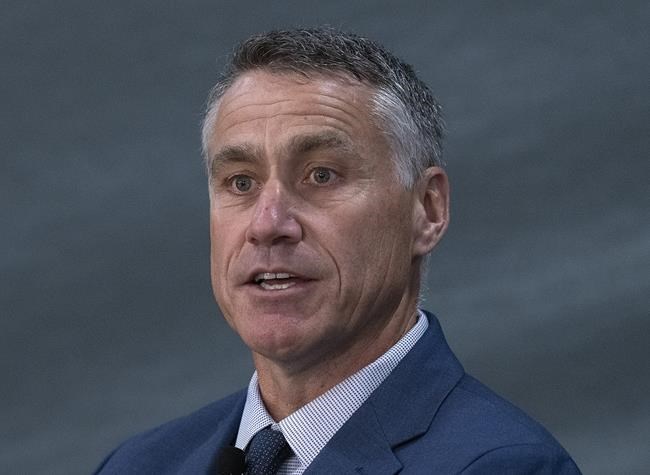
Jeff West, a retired RCMP staff sergeant who was a critical incident commander, provides testimony dealing with command post, operational communications centre and command decisions at the Mass Casualty Commission inquiry into the mass murders in rural Nova Scotia on April 18/19, 2020, in Dartmouth, N.S., on Wednesday, May 18, 2022. Gabriel Wortman, dressed as an RCMP officer and driving a replica police cruiser, murdered 22 people. THE CANADIAN PRESS/Andrew Vaughan
Republished May 18, 2022 - 1:54 PM
Original Publication Date May 18, 2022 - 9:06 AM
HALIFAX - A Mountie who led much of the response to the 2020 Nova Scotia mass shooting testified Wednesday that spotty radio service and the lack of an RCMP helicopter were among the equipment problems that hampered the manhunt.
A public inquiry into the April 18-19, 2020, killings is now hearing from senior RCMP officers about command decisions taken during the 13-hour rampage by a gunman who drove a replica police cruiser and murdered 22 people.
Jeff West, a staff sergeant who retired last year, was the critical incident commander from 1:19 a.m. until 10:20 a.m. on April 19, based in a firehall just east of Portapique, where the killings began.
It was more than two hours after he first received the call at home in Halifax that he arrived at the command post in Great Village, N.S.
When he got to the firehall to assume command, West said he initially couldn't broadcast over the police network from his portable radio. It was four minutes before he got a signal by standing next to a window. He told commission counsel Roger Burrill it was concerning that the portable radios lacked the power to allow a critical incident commander to announce his presence.
"It's an issue when you can't get on," he testified, adding that the problem was resolved once a radio technician arrived at the command post to set up a radio base station.
Kevin Surette, who supported West as a staff sergeant on April 19 and has also since retired, testified that poor radio service in crisis situations has been his experience throughout his decades-long career responding to major incidents.
"It's been a problem in every operation I've ever been involved in," he said. "I don't know the solution, but it bears some sort of investigation."
The quality of mapping was also discussed during testimony, as the inquiry heard that when West arrived, the sole map of Portapique was hand drawn. He testified that a technical officer who arrived later that night put up a Google map of the area.
According to evidence heard during the inquiry, all detachments in the province are supposed to have access to a licensed program called Pictometry, which offers access to high-resolution aerial photographs.
West said he didn't recall if he had asked for access to the Pictometry mapping. "Are there possibilities of better mapping? Definitely," he testified.
West also testified that the RCMP helicopter with thermal imaging technology wasn't available due to scheduled maintenance, adding that the helicopter would have been a valuable resource. He said he wasn't aware if the RCMP has a contingency plan in place for when the helicopter isn't available.
At one point, a supervisor at the RCMP's Operational Communication Centre in Truro, N.S., called the Joint Rescue Co-ordination Centre in Halifax to ask if the military could send a helicopter to help with the search for the gunman. The supervisor was told the military would not send a helicopter into an active shooter situation.
Retired staff sergeant Steve Halliday, the operations officer for the district at the time, testified on Tuesday that at various times the RCMP helicopter has not been available.
"Like any mechanical piece of equipment, there are times when it’s not available for whatever," he said. "The pilot’s down, the bird is down ... it’s down for routine maintenance, which occurs every so often."
A provincial aircraft without thermal imaging capabilities was provided to the RCMP by mid-morning, but Surette said once again there were troubles communicating with those on board due to radio problems.
Surette said the Department of Natural Resources helicopter's radio wasn't compatible with the law enforcement system, so an unencrypted radio system was used instead.
One key piece of technology that was available to the RCMP through the Emergency Management Office was the Alert Ready system, which would have permitted the RCMP to send out a public warning over cellphones, radio and television throughout the province.
Both Surette and West testified that they weren't aware of the ability to send out such a notice through the Emergency Management Office, and both testified it was "not in the (RCMP) tool box."
— With files from Michael MacDonald in Halifax.
This report by The Canadian Press was first published May 18, 2022.
News from © The Canadian Press, 2022